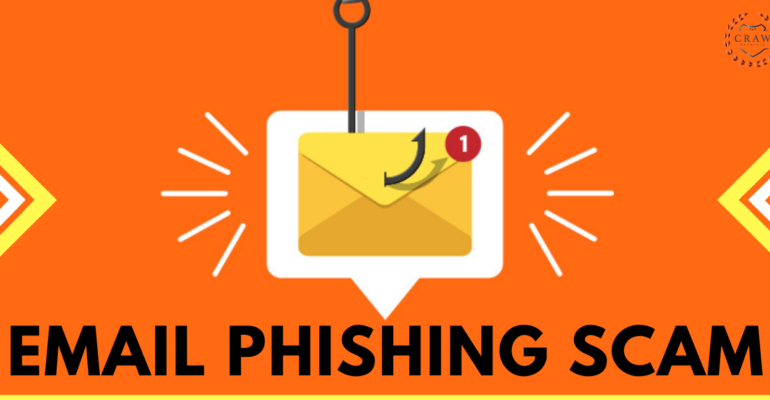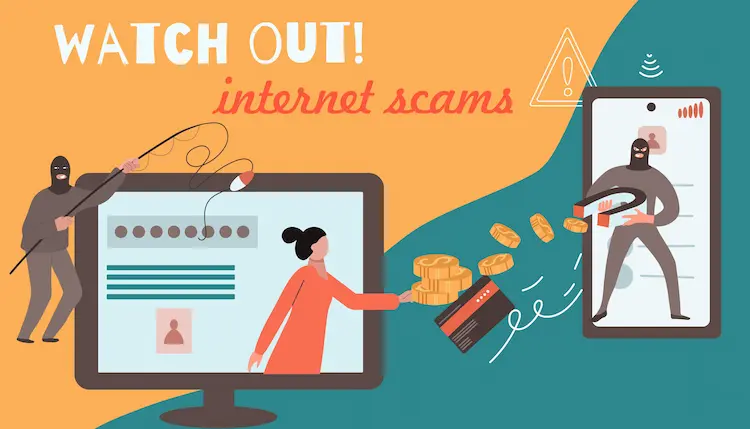Top Ways To Protect From Email Phishing Scams

Top Ways To Protect From Email Phishing Scams
Protect From Email Phishing Scam
We all know we should not click on suspicious or sketchy mail, yet we do! Phishing scams work in a simple way but getting you to click on a link or download an attachment that would enter into your system sets up malware or it might even take you to another webpage that does not look fishy but makes steal all your sensitive information.
What Does an Email Phishing Scam Mean?
Email phishing scams are one of the most common types of security threats these days. Hackers usually target organizations or individuals by sending them emails that may look very credible and from authentic sources like banks, government offices, clients,s or even managers of the same organizations. Basically, the sender of the mail traps the receiver into clicking on malicious links and then even makes them confirm their sensitive and personal information. People fall into traps of those emails thinking them to be genuine because of the name of the senders or the attractive content and then lose important information.
Top 20 Ways to Protect Organizations from Email Phishing Scam
Due to the lockdown, work from home has increased, and therefore, chances of getting trapped in these email phishing scams have also increased. Cybercriminals are attacking every day by sending around 18 million ransomware or phishing emails. Spamming has also increased in the email world. Almost 240 million spam emails are being sent on a daily basis containing Covid-19 information. Hackers mostly feed upon the fear or provide attractive financial benefits to people to get them to click on the emails. Working from home has its pros and cons and cybersecurity has become one of the biggest Cons. It is important that people should be aware of the ways to prevent email phishing scams, some of them are as follows:
- Educating and training the employees of the organization regarding cybersecurity with simulated phishing attacks giving them practical exposure.
- Implementing a tool that can verify emails like the Phishing Response tool to validate the emails from known/unknown senders that look suspicious.
- Any email asking for personal information should be dealt with carefully. Never reply to such emails immediately or without confirmation.
- It is always better to validate the sender’s email ID before proceeding further with the email
- Always avoid emails with very long links or no text in the body of the email.
- Often phishing emails contain grammatical errors or wrong spelling, one should be aware of this and keep it in mind at all times.
- Get unsolicited emails verified by the IT department of the organization before responding.
- Keep all email authentication protocols in places like DMARC, DKIM, and SPF to prevent domain forgery.
- Beware of Unexpected email attachments or suspicious mail links
- Encrypting your emails can be very beneficial in keeping all sensitive information secure.
- Take a good look at the URLs attached in the email body that can take you to another website with suspicious Landing pages.
- Emails sent at odd hours with irrelevant subject lines having suspicious domain names should never be replied to back
- Always check whether the link attached in the mail is beginning with ‘HTTP or not because otherwise, it may not be safe to open.
- One must always protect their accounts by a multi-layer authentication process for logging in.
- Beware of unsolicited emails with pop-ups or login forms asking for your account login credentials.
- Always keep a backup for your data to be on the safer side!
- Emails claiming to benefit you with financial incentives are usually fraudulent so, should not be trusted at all.
- Check for the Secure Socket Layer (SSL) certificate if there is any URL to be clicked on
- Keeping your systems and software updated with the best security patches can avoid any vulnerability.
- Lastly, Always stay aware and alert!

What is Email Phishing Scam?
Email Phishing Scams are generally comprised of deceptive objectives by malicious threat actors to acquire highly confidential and sensitive information, such as login credentials, financial particulars, or personal data, by posing as a reliable entity in electronic communication. The aforementioned fraudulent emails generally induce recipients to engage with malicious hyperlinks, download attachments that shelter malware, or divulge sensitive info under deceptive circumstances.
What is Phishing Email Attack?
In this world full of surprises, a random email with the intention of social engineering strategy to obtain confidential information for a person, a group of persons, or an entire organization can be showcased anytime in your email inbox. In general terms, a phishing email attack is a type of social engineering tactic taken into account by cyber criminals in order to create convincing emails that disguise authentic bodies, like banking institutions, government entities, or esteemed corporations.
In addition, just to influence recipients into engaging in acts that they generally do not in normal scenarios by luring them with tempting bonuses and offers to undermine their security posture, these emails commonly utilize elements like urgency, fear, temptation, greed, or curiosity.
Types of Phishing Attacks
Phishing attacks manifest in various forms, each tailored to exploit different vulnerabilities:
| Email Phishing | This is the predominant type of phishing, in which perpetrators send deceptive emails masquerading as authentic entities. These electronic communications frequently include malevolent hyperlinks or attachments that, once clicked or downloaded, have the potential to compromise the recipient’s equipment or illicitly acquire their personal information. |
| Spear Phishing | Spear phishing refers to a variant of phishing that involves the deliberate customization of emails by malicious actors to target certain individuals or organizations. Attackers can enhance their ability to fool recipients by collecting information about their targets from social media, websites, or other sources, enabling them to create highly customized emails. |
| Clone Phishing | Clone phishing involves the creation of a duplicate of a genuine email that has already been received by the intended recipient. The replicated email includes malevolent hyperlinks or attachments and presents itself as originating from a reliable source, hence increasing the likelihood of the receiver succumbing to the fraudulent scheme. |
| Whaling | Whaling is a form of phishing assault that specifically focuses on individuals of great prominence, such as chief executive officers (CEOs) or senior executives. Perpetrators frequently assume the identities of corporate executives or other reliable individuals in order to deceive receivers into divulging confidential data or transferring monetary resources. |
| Vishing | Vishing, often known as voice phishing, encompasses the utilization of telephone conversations by malicious actors to manipulate individuals into divulging confidential data or engaging in specific activities. Adversaries may employ counterfeit caller IDs or assume the identity of authentic organizations in order to enhance the credibility of their calls. |
| Smishing | The act of smishing bears resemblance to phishing, albeit executed over text messages (SMS). Adversaries dispatch deceitful text messages that include hyperlinks or contact numbers, deceiving recipients into divulging confidential data or downloading harmful material. |
| Search Engine Phishing | This form of assault involves the creation of counterfeit websites that are displayed in search engine results for often searched queries. When individuals access fraudulent websites and input their personal information, malicious actors have the ability to illicitly acquire their login credentials or implant malicious software onto their devices. |
| Business Email Compromise (BEC) | BEC attacks are directed at enterprises through the act of impersonating employees, executives, or business partners, with the intention of deceiving employees into engaging in fund transfers or divulging confidential information. |
| Ransomware Attacks | Although not universally classified as phishing, ransomware assaults frequently encompass the utilization of phishing emails with malevolent attachments or links. Upon activation, the virus proceeds to encrypt the data belonging to the victim and thereafter requests a ransom in exchange for decryption. |
| Malware-Based Phishing | Certain phishing assaults depend on malware to illicitly acquire information from the devices of their victims. Potential security threats encompass keyloggers, which capture and store keystrokes, as well as banking trojans, which illicitly acquire banking credentials. |
Phishing in Cybersecurity
In cybersecurity, phishing can be stated as the most cunning enemy that can persuasively take out highly sensitive and confidential information that a person would not open up to the general public. In an elaborative manner, phishing is a generic term that refers to the practice of sending misleading emails to a large number of people in an effort to trick individuals who are not paying attention into unknowingly giving sensitive information or downloading malicious software.
These Phishing emails come randomly along with your other business emails during working hours using the element of surprise by using your fear, urgency, temptation, greed, or curiosity.

How to Prevent Phishing?
Email phishing schemes require a genuine blend of vigilance, awareness, and strong security measures in order to be avoided. Here are several leading strategies for protecting against spoofing attacks:
| Educate and Train | In order to provide individuals with the ability to recognize suspicious emails and educate them about the perils of phishing schemes, organizations must give precedence to cybersecurity awareness training. |
| Verify Sender Identities | Examine the email address and domain of the sender at all times to verify its legitimacy. Phishers frequently employ subtle variations or misspellings in domain names as pretexts to deceive recipients. |
| Exercise Caution with Links and Attachments | It is advisable to avoid downloading attachments or acting on links in emails that appear unfamiliar or suspicious. Before clicking, hover over links to observe the URL and validate its authenticity. |
| Implement Email Filters and Security Software | Phishing emails and malicious attachments can be automatically identified and quarantined through the utilization of email filtering solutions and antivirus software. |
| Enable Multi-Factor Authentication (MFA) | For an additional layer of security, whenever possible implement MFA, which requires additional verification beyond passwords in order to access accounts. |
Phishing Attack Website
In general terms, Phishing attack websites are fraudulent sites that imitate legitimate websites to trick visitors into acquiring utmost sensitive information, like banking details, social media credentials, etc. Many complex and sophisticated techniques are frequently used by such types of Phishing Attack websites to copy the visual and tactile elements of genuine web pages, thereby rendering them challenging to differentiate from authentic sites.
FAQs
About Top Ways To Protect From Email Phishing Scams
1: What is a phishing email attack?
Phishing email attacks are a form of cyber attack in which malicious actors distribute deceptive electronic messages posing as authentic entities. The primary objective of these email schemes is to deceive recipients into revealing confidential data, including credit card numbers, passwords, or personal information, or selecting harmful links or attachments.
2: What is a phished email?
When an email is phished, it has been the target of a phishing attack. A malicious actor has sent an email that masquerades as originating from a reputable source but is in fact designed to trick the recipient into divulging sensitive information or performing a detrimental action.
3: What are examples of phishing emails?
Phishing emails include those purporting to be from a financial institution or bank and requesting account information; those posing as from a legitimate company and requesting login credentials; and those purporting to be from a government agency and requesting personal information.
4: What is a phishing scam malware email?
Phishing scam malware emails are composed of malicious software (malware) that targets the recipient’s computer or network with the intention of stealing sensitive data. Frequently, a link or attachment in this variety of email prompts the recipient to install malware on their device.
5: What is a famous example of phishing?
The phishing attack that targeted the Democratic National Committee (DNC) during the 2016 U.S. presidential election is a well-known instance of phishing. Phishing emails were utilized to deceive DNC personnel into divulging their email credentials by the hackers, who then gained access to sensitive data.
6: How is phishing done?
Phishing is commonly executed via email, wherein perpetrators distribute deceptive messages masquerading as authentic correspondence. Malicious attachments and links to bogus websites are common in these communications. By opening the attachments or clicking on the links, recipients are duped into divulging sensitive information or downloading malicious software.
7: What are the 4 types of phishing?
The four main types of phishing are:
- Email phishing,
- Spear phishing,
- Clone phishing,
- Whaling, etc.
8: Which phishing tool is best?
The utilization of phishing tools for fraudulent reasons is unlawful and unacceptable; hence, there is no “best” phishing tool. Phishing tools are specifically engineered to assist cybersecurity professionals in the evaluation and enhancement of system security through the controlled simulation of phishing attacks.
9: Why is it called phishing?
Phishing derives its name from a satirical play on the word “fishing.” Phishing involves malicious actors “fishing” for confidential data from individuals who are unaware of the dangers involved, analogous to how a fisherman “fishes” for fish in a body of water.
10: Who uses phishing?
Cybercriminals and hackers who wish to illicitly obtain sensitive data, including passwords, credit card numbers, or confidential information, employ phishing techniques. Phishing attacks may be executed by organized organizations or individuals.
11: Where is phishing used?
Phishing can occur in any digital environment, including social media, email, and text messages. Targeting businesses, organizations, and individuals with the intent of stealing sensitive data or distributing malware is a common occurrence.
Wrapping Up
In the bottom line, we would like to say that email phishing schemes in reality present a substantial danger to both persons and organizations whosoever come to confront them unwillingly. Nevertheless, these risks can be effectively mitigated through the implementation of proactive measures and appropriate cybersecurity training.
This type of superb cybersecurity training against such email phishing attacks and other types of cyber attacks can be provided by Craw Security, which is the best cybersecurity training institute in India, and provides individuals with the necessary expertise and capabilities to safeguard digital assets and counter ever-evolving cyber threats. You can enquire about anything more related to the upcoming batches of the Best Cybersecurity Training Programs by Craw Security by calling our hotline number +91-9513805401 and have a word with our highly excelled team of study consultants.
Moreover, by maintaining awareness, exercising utmost caution, and establishing strong security protocols, we can all work together to safeguard ourselves against the ubiquitous menace posed by email phishing schemes.
















